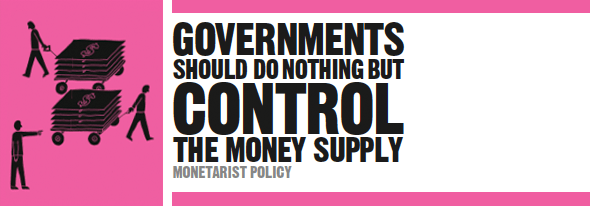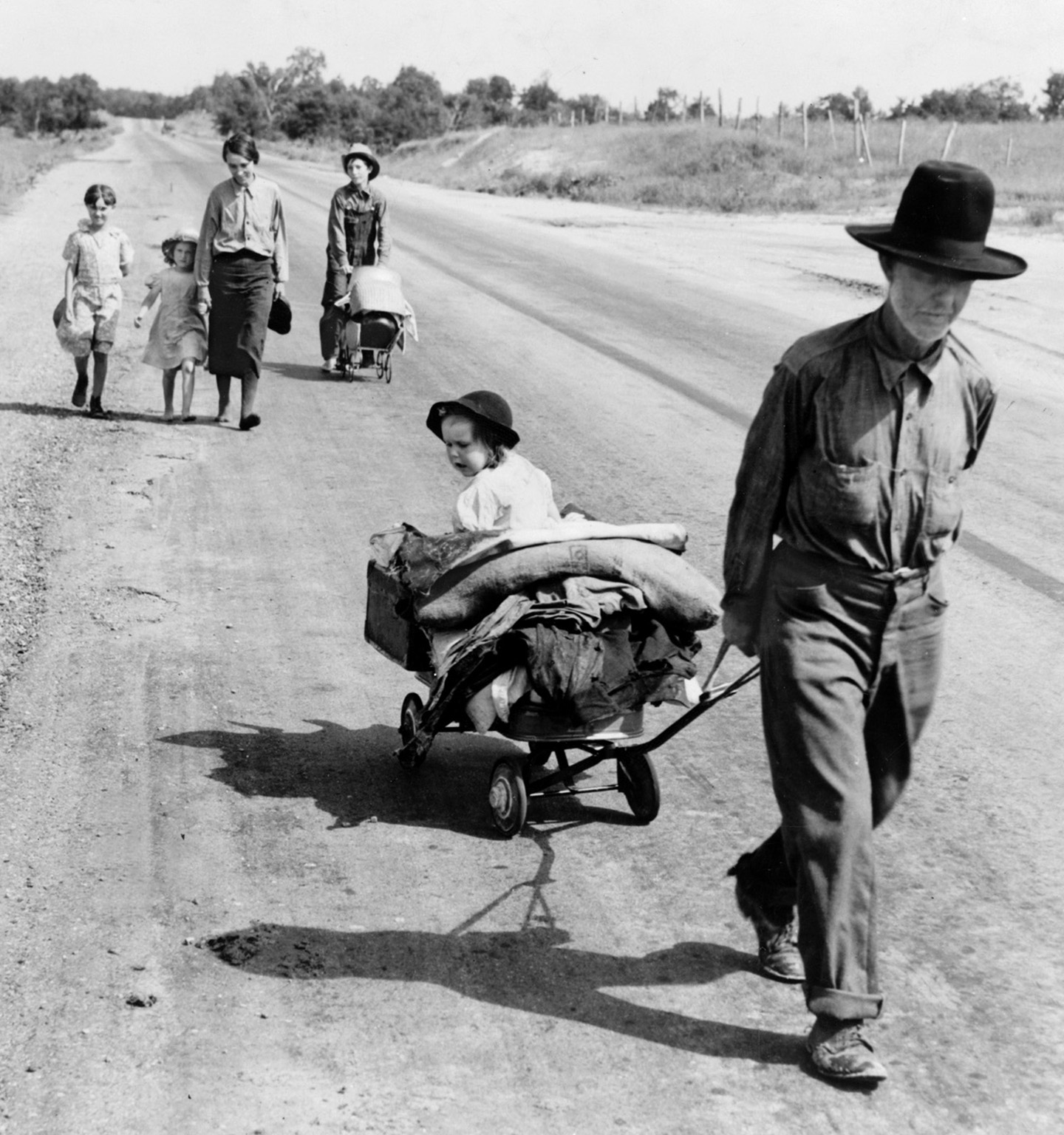

Economic policy
Milton Friedman (1912–2006)
1911 Irving Fisher formalizes the quantity theory of money, which proposes that prices are directly related to the size of the money supply.
1936 John Maynard Keynes questions the effectiveness of policies to control the money supply.
1970s Robert Lucas develops models that assume “rational expectations.”
1970s–80s Many countries adopt formal monetary growth targets, by which governments attempt to control growth in the size of the money supply in order to keep down inflation.
Writing in the 1930s, John Maynard Keynes argued that policies aimed at controlling the money supply were often ineffective. He believed that altering interest rates or the money supply did not affect the economy in a predictable way. Instead, governments could better use fiscal policy—changing the mix of government spending and taxation—to protect against unemployment or inflation. By 1945, his views were widely accepted.

From the 1950s, however, US economist Milton Friedman began to challenge Keynes with the idea that “money matters.” Friedman believed that money affects output in the short run and prices only in the long run. He argued that monetary policy has a valuable role to play in managing the economy: an idea now known as monetarism.
"Inflation is taxation without legislation."
Milton Friedman
In 1963, Friedman published A Monetary History of the United States, 1867–1960 with his colleague Anna Schwartz. They tracked the role of money in business cycles, finding that fluctuations in monetary growth preceded fluctuations in output growth. In particular they attributed the Great Depression of 1929–33 to the incompetence of the Federal Reserve, the central bank of the US, allowing or causing the quantity of money to fall by more than one third.

The Great Depression saw millions of Americans migrate west in search of work on farms. Milton Friedman blamed the slump on the Federal Reserve’s reduction in the money supply.
Keynes’s case for government spending in a slump was based partly on his ideas about consumption. He argued that as people’s income rises, their consumption also goes up, but not by as much. In a slump people hoard money, which prolongs the slump. State spending in such a situation increases incomes and has a large, predictable effect on consumption, restoring the economy to full employment.
In 1957, Friedman published A Theory of the Consumption Function, an important work that began to challenge the Keynesian orthodoxy. Friedman argued that people distinguish between “permanent income”—their stable long-term earnings, which they feel confident to consume—and “transitory income”, which is less permanent, can be positive or negative, and which does not affect their consumption. Those with high incomes will have high transitory income and consume only a small share of their total income; those with the lowest incomes will have negative transitory income and will consume more than their income. But if you add all their incomes together, the positive and negative transitory incomes largely cancel each other out. Friedman’s theory seemed to fit the evidence well. In a cross-section of the population, consumption did not rise much with income. But, measured over time and looking at the total population (so that transitory income effects cancelled out), consumption did rise with income. Friedman concluded that Keynes’s model of consumption was wrong. State spending would be treated as transitory income and would simply “crowd out” private spending. Continuing slumps caused by inadequate consumption would not happen.
Friedman aimed to show that monetary policy works: a change to the amount of money in the economy has a predictable effect on total incomes. Keynes had suggested that this relationship was unstable because people held money for different reasons; some of these reasons were what he called “speculative” and hard to pin down. To help prove the quantity theory right, Friedman needed to show that the demand for money is stable. He had to come up with a testable theory about the demand for money.
In 1956, Friedman published The Quantity Theory of Money: A Restatement. He treated money as a good, a “temporary abode of purchasing power.” The market demand for a good depends on people’s overall budget and its relative price against other competing goods, as well as buyers’ tastes. Friedman thought that the demand for money would be influenced by various factors. First, it would increase with the general level of prices, since money is wanted for its purchasing power over real goods. It would also be influenced by people’s “real” wealth or their permanent income, and the returns on money, bonds, equities, and durable goods. Finally, demand for money would be influenced by “tastes,” which in this context means factors such as economic uncertainty, which leads people to want to hold money.
Given a well-defined level of demand for money, an extra supply of money would not be required by consumers: they would already be holding the money that they needed. They would therefore spend any extra cash. Prices do not adjust instantly in the short run, so this would lead to higher output. But in the long run, prices would adjust, and the only effect of the extra money would be higher prices. Friedman’s approach can therefore be seen as a revival of the quantity theory of money, a formula that states MV = PT, where “M” is the money supply and “V” represents how quickly money circulates. “P” is the price level, and by multiplying this by “T,” the number of transactions, we arrive at the total value of transactions. Roughly, this equation says that if V and T are constant then a higher money supply means a higher price level. In the long run money has no “real” effects on the economy.

A man papers his wall with money during the German hyperinflation of 1923. Friedman thought that state intervention to reduce unemployment inevitably led to high inflation.
The word “monetarism” was first used in 1968, the year that Friedman presented a new account of the Phillips Curve. This showed the supposedly stable relationship between inflation and unemployment, which allowed governments to choose between less inflation with more unemployment, or more inflation with less unemployment. Friedman denied that such a trade-off exists, except in the very short run. He said there is a single “natural rate” of unemployment, which consists of unemployed workers temporarily in the process of looking for jobs. In practice the economy is at full employment when unemployment is at this natural rate. If governments spend money to reduce unemployment below the natural rate, pushing up inflation, wage earners will further inflate their wage demands. Two things can then happen. Unemployment can return to the natural rate, at the new, higher inflation rate. Or the government tries to maintain the lower unemployment level, but at the cost of a spiral of accelerating inflation.
The conclusion was clear: it is futile for governments to try to stabilize employment through fiscal policy. Increasing the money supply likewise only leads to higher prices. In the long run the Phillips Curve is a straight vertical line at the natural rate of unemployment.
The time lag between monetary changes and output changes is often only a few quarters. Price movements can take between one to two years or more to come through. These lags are considerably variable. For this reason Friedman advised governments against trying to use monetary policy to actively manipulate markets because it is easy to misread what is happening in the economy. They should follow a simple rule: ensure that money, however it is defined, increases by a constant amount—2–5 percent (depending on the definition of money chosen) annually.
The new classical macroeconomics school, led by US economists Robert Lucas and Thomas Sargent, put forward a revised version of this argument based on rational expectations of future economic policy. Friedman’s model treated expectations as if they only adapted to past mistakes. Lucas and Sargent argued that people’s expectations are forward-focused. People can see what governments might plan, so any government attempt to reduce unemployment below the natural rate will lead immediately to higher inflation. In other words the Phillips Curve is vertical in the short run as well—governments don’t ever have the power to reduce unemployment.

Between 1975 and 1999, the US government set yearly targets for growth in the money supply. However, it regularly grew by more than the upper limit of the government target.
It did not take long for Friedman’s warnings to be proven correct. In the 1970s the supposed Phillips Curve trade-off fell apart when both inflation and unemployment increased together—a phenomenon known as stagflation. Governments started to introduce targets for growth in the money supply into their planning. Germany, Japan, the US, the UK, and Switzerland adopted monetary targeting in the 1970s. However, it proved hard to control monetary growth. One problem was which form of money to target. Most central banks targeted a broad version of money, which included bank time deposits (deposits that cannot be withdrawn for a fixed period of time). However, this proved hard to control. Attention then focused on the narrow monetary base, namely notes, coins, and reserves held at the central bank. This was easier to control but did not seem to enjoy a stable relationship with so-called broad money.
Monetarist experiments were largely unsuccessful, but the impact of monetarism was significant. It grew from a policy prescription about the money supply to a program aimed at reducing government involvement in all aspects of the economy. Few today would disagree that “money matters.” Monetary policy receives as much attention as fiscal policy and is usually aimed at controlling inflation. But the purest form of monetarism and its policy implications rely on controversial assumptions: that there is a predictable demand for money and that the money supply can easily be controlled by the authorities. In the 1990s countries moved away from monetary targeting. Many began to use the exchange rate to control inflation or to tie interest rate policy directly to inflation trends.

In 1973, Chile became the first country to implement monetarist policies. Under dictator Augusto Pinochet, a radical program of cuts and privatizations was carried out.

US president Ronald Reagan and UK prime minister Margaret Thatcher were close conservative allies. Both pursued strict monetarist policies in their early years in office.

Born in Brooklyn, New York, in 1912, Milton Friedman was the son of Hungarian immigrants. He was taught by the US’s top economists—at Rutgers, New Jersey, for his bachelor’s degree; Chicago for his master’s; and Columbia, New York, for his PhD. At Chicago he met economics student Rose Director. They married in 1938, and collaborated throughout their careers. From 1935 to 1946, he worked as a statistician and economist in New York and Washington. From 1946 to 1976, he taught at the University of Chicago. It was there that he became well-known. His fame increased with the 1980 TV series and book Free to Choose. He was an advisor to Presidents Richard Nixon and Ronald Reagan. He died in 2006.
1957 A Theory of the Consumption Function
1963 A Monetary History of the United States, 1867–1960 (with Anna Schwartz)
1967 The Role of Monetary Policy Presidential address to the American Economic Association